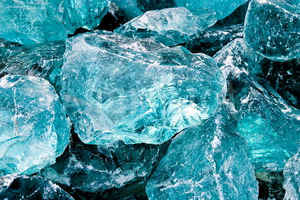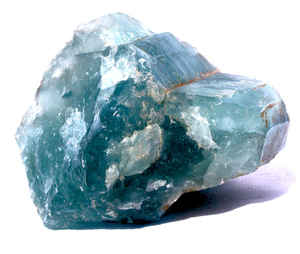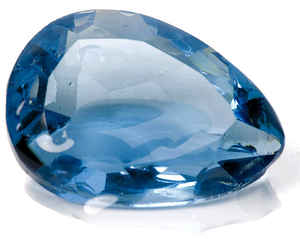Colorado State Gemstone or Gem
Aquamarine

(Be3Al2(SiO3)6 - Beryllium Aluminium Silicate)
Adopted on April 30, 1971.
The aquamarine, (Be3Al2(SiO3)6 - Beryllium Aluminium Silicate,) was adopted as the official state gemstone on April 30, 1971, by an act of the General Assembly House Bill 1104, 1971; Colorado Revised Statute 24-80-912.
Aquamarine: Colorado State Gemstone or Gem

Aquamarine (from Latin: aqua marina, "water of the sea") is a blue or turquoise variety of beryl. It occurs at most localities which yield ordinary beryl. The gem-gravel placer deposits of Sri Lanka contain aquamarine. Clear yellow beryl, such as that occurring in Brazil, is sometimes called aquamarine chrysolite. The deep blue version of aquamarine is called maxixe.
The pale blue color of aquamarine is attributed to Fe2+. The Fe3+ ions produce golden-yellow color, and when both Fe2+ and Fe3+ are present, the color is a darker blue as in maxixe. Decoloration of maxixe by light or heat thus may be due to the charge transfer Fe3+ and Fe2+. Dark-blue maxixe color can be produced in green, pink or yellow beryl by irradiating it with high-energy particles (gamma rays, neutrons or even X-rays).
In the United States, aquamarines can be found at the summit of Mt. Antero in the Sawatch Range in central Colorado. In Wyoming, aquamarine has been discovered in the Big Horn Mountains, near Powder River Pass.
The mountain peaks of Mount Antero and White Mountain in Colorado are among the finest quality localities known for gem aquamarine. They are also among the highest in elevation, located at 14,000 feet. The granite rock of these peaks contains pegmatite bodies that are characterized by large miarolitic cavities containing the gem quality aquamarine crystals. The cavities are found through a vertical area of a mere 500 feet. The crystals in these cavities range in color from light blue to pale and deep aquamarine green, and in size from very small to 6 cm in length.
MARCH Birthstone: Aquamarine:

The name aquamarine was derived by the Romans, "aqua,"meaning water, and "mare,"meaning sea, because it looked like sea water. Aquamarines were believed to have originated from the jewel caskets of sirens, washed ashore from the depths of the sea. They were considered sacred to Neptune, Roman god of the sea. It is associated with the sea because of its distinctive blue-green hues, aquamarine symbolizes loyalty, honesty, and beauty, and was believed to protect sailors as well as to guarantee a safe voyage. Its first documented use was by the Greeks between 480-300 BC. They wore aquamarine amulets engraved with Poseidon (the Greek god of the sea) on a chariot. Victorians gave this jewel to guarantee marital happiness and devotion. It is also considered to be a universal symbol of youth, hope, and happiness. Aquamarine is a pastel stone that is greenish-blue in color. The name is derived from Latin, meaning "sea"and "water."Hues range from a nearly colorless whitish-blue to a rich teal, but the most valued color is a vivid blue aqua shade.
Colorado Law
The law designating the aquamarine as the official Colorado state gemstone is found in the Colorado Revised Statute, Title 24, Part 9, Sections 24-80-912
TITLE 24. GOVERNMENT - STATE
STATE HISTORY, ARCHIVES, AND EMBLEMS
ARTICLE 80.STATE HISTORY, ARCHIVES, AND EMBLEMS
PART 9. STATE EMBLEMS AND SYMBOLS
C.R.S. 24-80-912 (2013)
24-80-912. State gemstone
The aquamarine is hereby made and declared to be the state gemstone of the state of Colorado.
HISTORY: Source: L. 71: p. 1221, § 1. C.R.S. 1963: § 131-8-12.
Citation: House Bill 1104, 1971; Colorado Revised Statute 24-80-912.
Minerals, & Gems

Gemstone, Minerals, Rocks







